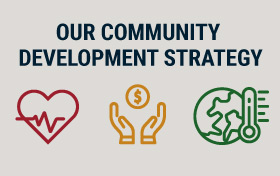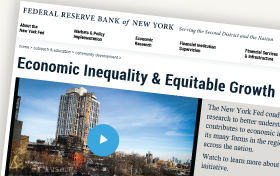How Much Is Priced In? Market Expectations for FOMC Rate Hikes from Different Angles

It is essential for policymakers and financial market participants to understand market expectations for the path of future policy rates because these expectations can have important implications for financial markets and the broader economy. In this post—which is meant to complement prior Liberty Street Economics posts, including Crump et al. (2014a, 2014b ) and Brodsky et al. (2016a, 2016b)—we offer some insights into estimating and interpreting market expectations for increases in the federal funds target range at upcoming meetings of the Federal Open Market Committee (FOMC).
Did Investor Sentiment Affect Credit Risk around the 2016 Election?

Immediately following the presidential election of 2016, both consumer and investor sentiments were buoyant and financial markets boomed. That these sentiments affect financial asset prices is not so surprising, given past stock market evidence and episodes such as the dot-com bubble. Perhaps more surprising, the risk of corporate default—which is driven mainly by firms’ financial health but also by bond liquidity—also fell following the election, as indicated by lower yield spreads. In this post, I show that, although expectations of better corporate and macroeconomic conditions were the primary drivers of lower credit risk, improved investor sentiment also contributed.
The New York Fed DSGE Model Forecast–November 2017
This post presents our quarterly update of the economic forecasts generated by the Federal Reserve Bank of New York’s dynamic stochastic general equilibrium (DSGE) model. We describe very briefly our forecast and its change since August 2017.
What Makes a Safe Asset Safe?

Over the last decade, the concept of “safe assets” has received increasing attention, from regulators and private market participants, as well as researchers. This attention has led to the uncovering of some important details and nuances of what makes an asset “safe” and why it matters. In this blog post, we provide a review of the different aspects of safe assets, discuss possible reasons why they may be beneficial for investors, and give concrete examples of what these assets are in practice.
Are Student Loan Defaults Cyclical? It Depends

This post is the second in a two-part series on student loan default behavior. In the first post , we studied how educational characteristics (school type and selectivity, graduation, and major) and family background relate to the incidence of student loan default. In this post, we investigate whether default behavior has varied across cohorts of borrowers as the labor market evolved over time. Specifically, does the ability of student loan holders to repay their loans vary with the state of the labor market? Does the type of education these students received make any difference to this relationship?
Who Is More Likely to Default on Student Loans?

This post seeks to understand how educational characteristics (school type and selectivity, graduation status, major) and family background relate to the incidence of student loan default. Student indebtedness has grown substantially, increasing by 170 percent between 2006 and 2016. In addition, the fraction of students who default on those loans has grown considerably. Of students who left college in 2010 and 2011, 28 percent defaulted on their student loans within five years, compared with 19 percent of those who left school in 2005 and 2006. Since defaulting on student loans can have serious consequences for credit scores and, by extension, the ability to purchase a home and take out other loans, it’s critical to understand how college and family characteristics correspond to default rates.
The Low Volatility Puzzle: Is This Time Different?

As stock market volatility hovers near all-time lows, some analysts are questioning whether investors are complacent, drawing an analogy to the lead-up to the financial crisis. But, is this time different? We follow up on our previous post by investigating the persistence of low volatility periods. Historically, realized stock market volatility is persistent and mean-reverting: low volatility today predicts slightly higher, but still low, volatility one month and one year from now. Moreover, as of mid-September, the market is pricing implied volatility of 19 percent in one to two years’ time. This level contrasts with the pre-crisis period when the term structure of implied volatility was relatively flat, which suggests this time may indeed be different, at least as measured by market participants’ pricing of risk.
Just Released: Auto Lending Keeps Pace as Delinquencies Mount in Auto Finance Sector

Total household debt increased by $116 billion to reach $12.96 trillion in the third quarter of 2017, according to the latest Quarterly Report on Household Debt and Credit released today by the New York Fed’s Center for Microeconomic Data. Household debt has been growing since mid-2013, boosted in part by steady growth in auto loan balances, which have grown for twenty-six consecutive quarters thanks to record-high levels of newly originated loans. Although new vehicle sales had begun to slump over the summer after several strong years of growth, September and October saw a rebound in sales, ending with over 18 million vehicles sold (seasonally adjusted at an annualized rate), and auto loan originations in the third quarter were commensurate with these numbers. In this post, we revisit the state of auto lending and auto loan performance, using the New York Fed Consumer Credit Panel which is based on Equifax credit data.
The Low Volatility Puzzle: Are Investors Complacent?

In recent months, some analysts and policymakers have raised concerns about the unusually low level of stock market volatility. For example, in the June Federal Open Market Committee (FOMC) minutes “a few participants expressed concern that subdued market volatility, coupled with a low equity premium, could lead to a buildup of risks to financial stability.” In this post, we review this concern and find the evidence on investor complacency is mixed. On one hand, we present a view suggesting that historical volatility may have been abnormally high, rather than current volatility being abnormally low. On the other hand, we find that estimates of the volatility risk premium are somewhat low, which is consistent with the view that investor risk tolerance has increased. We extend this analysis in a related post publishing on Wednesday.
Understanding Permanent and Temporary Income Shocks

The earnings of 200 million U.S. workers change each year for various reasons. Some of these changes are anticipated while others are more unexpected. Although many of these changes may be due to pleasant surprises—such as receiving salary raises and promotions—others involve disappointments—such as falling into unemployment. Arguably, some of these factors have rather short-lived effects on an individual’s earnings, whereas others may have permanent effects. Many labor economists have been interested in these various shocks to earnings. How big are the more permanent shocks to earnings? How large are they relative to those that are temporary in nature? What are the sources of these shocks? In this blog post, we exploit a novel data set that enables us to explore the properties of earnings shocks: their magnitudes as well as their origins.














 RSS Feed
RSS Feed Follow Liberty Street Economics
Follow Liberty Street Economics